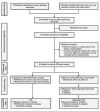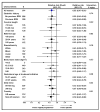Vaginal progesterone for preventing preterm birth and adverse perinatal outcomes in singleton gestations with a short cervix: a meta-analysis of individual patient data
- PMID: 29157866
- PMCID: PMC5987201
- DOI: 10.1016/j.ajog.2017.11.576
Vaginal progesterone for preventing preterm birth and adverse perinatal outcomes in singleton gestations with a short cervix: a meta-analysis of individual patient data
Abstract
Background: The efficacy of vaginal progesterone for preventing preterm birth and adverse perinatal outcomes in singleton gestations with a short cervix has been questioned after publication of the OPPTIMUM study.
Objective: To determine whether vaginal progesterone prevents preterm birth and improves perinatal outcomes in asymptomatic women with a singleton gestation and a midtrimester sonographic short cervix.
Study design: We searched MEDLINE, EMBASE, LILACS, and CINAHL (from their inception to September 2017); Cochrane databases; bibliographies; and conference proceedings for randomized controlled trials comparing vaginal progesterone vs placebo/no treatment in women with a singleton gestation and a midtrimester sonographic cervical length ≤25 mm. This was a systematic review and meta-analysis of individual patient data. The primary outcome was preterm birth <33 weeks of gestation. Secondary outcomes included adverse perinatal outcomes and neurodevelopmental and health outcomes at 2 years of age. Individual patient data were analyzed using a 2-stage approach. Pooled relative risks with 95% confidence intervals were calculated. Quality of evidence was assessed using the GRADE methodology.
Results: Data were available from 974 women (498 allocated to vaginal progesterone, 476 allocated to placebo) with a cervical length ≤25 mm participating in 5 high-quality trials. Vaginal progesterone was associated with a significant reduction in the risk of preterm birth <33 weeks of gestation (relative risk, 0.62; 95% confidence interval, 0.47-0.81; P = .0006; high-quality evidence). Moreover, vaginal progesterone significantly decreased the risk of preterm birth <36, <35, <34, <32, <30, and <28 weeks of gestation; spontaneous preterm birth <33 and <34 weeks of gestation; respiratory distress syndrome; composite neonatal morbidity and mortality; birthweight <1500 and <2500 g; and admission to the neonatal intensive care unit (relative risks from 0.47-0.82; high-quality evidence for all). There were 7 (1.4%) neonatal deaths in the vaginal progesterone group and 15 (3.2%) in the placebo group (relative risk, 0.44; 95% confidence interval, 0.18-1.07; P = .07; low-quality evidence). Maternal adverse events, congenital anomalies, and adverse neurodevelopmental and health outcomes at 2 years of age did not differ between groups.
Conclusion: Vaginal progesterone decreases the risk of preterm birth and improves perinatal outcomes in singleton gestations with a midtrimester sonographic short cervix, without any demonstrable deleterious effects on childhood neurodevelopment.
Keywords: cervical length; prematurity; preterm delivery; progestins; progestogens; transvaginal ultrasound.
Published by Elsevier Inc.
Conflict of interest statement
Disclosure: RR, AC-A, EDF, EC, SSH, and KHN declare no conflict of interest. JMO’B was involved in studies of progesterone gel treatment for preterm birth prevention sponsored by a maker of progesterone gel. He served on advisory boards and as a consultant for Watson Pharmaceuticals, a company with a financial interest in marketing vaginal progesterone gel for preterm birth prevention; he and others are listed in a patent on the use of progesterone compounds to prevent preterm birth (USA Patent Number 7884093: progesterone for the treatment and prevention of spontaneous preterm birth). He has received no royalty payments. GWC was an Employee of Columbia Laboratories, Inc. when the previous meta-analysis of individual patient data was conducted in 2011.
Professor Jane Norman has no conflict of interest in relation with our meta-analysis of individual patient data.
Figures




Comment in
-
Prevention of spontaneous preterm birth: universal cervical length assessment and vaginal progesterone in women with a short cervix: time for action!Am J Obstet Gynecol. 2018 Feb;218(2):151-158. doi: 10.1016/j.ajog.2017.12.222. Am J Obstet Gynecol. 2018. PMID: 29422255 No abstract available.
-
Perhaps cerclage is the ideal treatment for the cervix <1 cm.Am J Obstet Gynecol. 2018 Aug;219(2):213. doi: 10.1016/j.ajog.2018.04.004. Epub 2018 Apr 7. Am J Obstet Gynecol. 2018. PMID: 29630883 No abstract available.
-
There is insufficient evidence to claim that cerclage is the treatment of choice for patients with a cervical length <10 mm.Am J Obstet Gynecol. 2018 Aug;219(2):213-215. doi: 10.1016/j.ajog.2018.04.009. Epub 2018 Apr 12. Am J Obstet Gynecol. 2018. PMID: 29654737 Free PMC article. No abstract available.
References
-
- Blencowe H, Cousens S, Oestergaard MZ, et al. National, regional, and worldwide estimates of preterm birth rates in the year 2010 with time trends since 1990 for selected countries: a systematic analysis and implications. Lancet. 2012;379:2162–72. - PubMed
-
- Martin JA, Hamilton BE, Osterman MJ, Driscoll AK, Mathews TJ. Births: Final Data for 2015. Natl Vital Stat Rep. 2017;66:1. - PubMed
-
- Liu L, Oza S, Hogan D, et al. Global, regional, and national causes of child mortality in 2000-13, with projections to inform post-2015 priorities: an updated systematic analysis. Lancet. 2015;385:430–40. - PubMed
-
- Institute Of Medicine Committee On Understanding Premature B, Assuring Healthy O. The National Academies Collection: Reports funded by National Institutes of Health. In: Behrman RE, Butler AS, editors. Preterm Birth: Causes, Consequences, and Prevention. Washington (DC): National Academies Press (US), National Academy of Sciences; 2007. - PubMed
-
- Saigal S, Doyle LW. An overview of mortality and sequelae of preterm birth from infancy to adulthood. Lancet. 2008;371:261–9. - PubMed
Publication types
MeSH terms
Substances
Grants and funding
LinkOut - more resources
Full Text Sources
Other Literature Sources
Medical

